Articles
From Household to School House:
The Emergence of the Teacher as Servant of the State
Résumé
Cet article explore les rapports qui existent entre l'enseignement scolaire et les changements qui se produisent dans le milieu matériel et social où il est dispensé, compte tenu de l'évolution de la structure sociale du corps enseignant. L'auteur analyse d'abord la pédagogie et les conditions de travail des enseignants (principalement dans le Haut-Canada et en Ontario) en fonction des innovations introduites par l'État et de questions litigieuses comme la fréquentation scolaire, la construction des bâtiments scolaires et la conception des classes, le matériel pédagogique et la responsabilité de l'entretien de l'école. En s'inspirant des ouvrages de Marta Danylewycz sur le Québec, ainsi que d'Alison Prentice et de Beth Light sur l'Ontario, l'auteur expose brièvement la structure sociale de l'enseignement et montre comment les changements qui s'y produisent peuvent se rapporter au milieu de travail et au matériel dont disposent les enseignants. En conclusion, on présente un essai de chronologie sur l'histoire de l'enseignement.
Abstract
This paper explores the relationships between school teaching and changes in the material and social environment in which the work of teaching occurred, and between both of these and the changing social structure of the teaching force. First, nineteenth-century pedagogy and working conditions for teachers (chiefly in Upper Canada and Ontario) are analyzed in terms of state-promoted innovations and debates affecting attendance, school building and classroom design, teaching tools and who should clean the school. This is followed by a brief discussion, drawing on the work of Marta Danylewycz on Quebec and Alison Prentice and Beth Light on Ontario, of the social structure of teaching and how changes in this structure might be related to the material environment and tools of teachers' work in schools. The paper concludes with a suggested periodization for the history of teachers.
1 Mary O'Brien and Anne Langton were early Upper Canadians who "kept school." During one period of her life in Canada, Anne Langton, a spinster who devoted her life chiefly to housekeeping for brothers in Canada and England, took in neighbours' children to teach a few days a week. Not all that enamoured of her "untutored children of the forest," she nevertheless believed it her duty to spread British culture to the inhabitants of the Canadian backwoods. Mary O'Brien's motives were rather different. She took in a pupil in order to have, in exchange, the young woman's help with her own children and the housework. Mary's pupil lived with her teacher's family and she and the O'Brien daughters were taught together.1
2 Domestic schools of the sort run by Mary O'Brien and Anne Langton were not uncommon in British North America. They clearly had long roots in a past which did not distinguish very sharply between pupils and servants or between the mistresses and masters of households and the mistresses and masters of schools. To examine the shift from the kind of teacher represented by Langton and O'Brien to the modern teacher is to explore a major shift in the nature of work in schools: a transition encompassing not only the work itself, but the work-place and the social characteristics of the workers.
3 North American studies in the history of teaching have unveiled many aspects of the shift. Studies of the ideology surrounding the movement of women from domestic or private into public school teaching followed earlier work which focused on the quest for professionalism in an occupation that was relatively poorly paid and tended to attract large numbers of transient or temporary workers.2 More recently, research and writing in the history of teachers has focused on the teachers themselves: on the organization of teacher associations, sexual divisions of labour in the occupation, and cultural and regional variations in its history.3 What follows is in part a summary of some Canadian findings in this research. In part it is also an attempt to open up a new approach to this history of teaching, one which focuses on the relationships that can be traced between the teachers — who they were, where they came from, and how they were seen in the community — and the work that they did in and out of schools.
Ⅰ
4 To begin with the work is to consider the work-place. One of the most significant transitions that has occurred between Mary O'Brien and Anne Langton's time and our own clearly has been the shift from the private or family school, conducted in the household of its teacher or teachers, to the non-domestic or public institution, conducted in a building now formally identified as a school house or, eventually, simply as a school. In terms of their own numbers, the vast majority of schools continued to be carried on in the rooms of private dwellings or in the transitional one-room schools that dotted the Canadian landscape for most of the nineteenth century. In terms of numbers of pupils and teachers, however, by the end of that century and certainly by the first quarter of the twentieth, more and more of those involved in schooling were spending their working days in larger structures: the two- or three-room schools of villages or the even more grand, graded institutions of towns and cities. The latter, of course, were the prototypes of the future. By the mid-twentieth century it is certain that the majority of teachers and pupils alike were to be found in such institutions, despite the persistence in some locations and the continuing mystique of the one-room rural school.
5 On the grounds that the physical environment in which schooling took place necessarily affected (and was affected by) the teacher's work, it is worth examining in some detail. In traditional domestic or family schools, pupils were instructed in kitchens, in parlours, or in upstairs rooms set aside for the purpose. Somewhat untypically, perhaps, an Ancaster, Upper Canada, schoolmistress even proposed in 1828 to conduct her school in a neighbour's ballroom. The furnishings in such schools were essentially the chairs and tables or, in more simple surroundings, the stools and benches that the household possessed, multiplied according to the number of scholars to be accommodated. In the early one-room school house, benches or "forms" provided the most common seating for pupils, while the teacher was usually provided with a chair or a stool. Although writing desks were increasingly thought necessary, they were often placed along the walls and were rarely sufficient to accommodate all the scholars at any one time. Nor did every teacher enjoy the privilege of a desk in the first school houses.4
6 It is interesting to speculate on the probable relationship between these physical surroundings and the teacher's work. Chairs and the ordinary furnishings of houses suggest the possibility of a mobile, fairly flexible atmosphere. With benches we are already moving toward the immobilization of the pupils who typically now would be lined up in rows facing the teacher. Yet the bench was still a potentially flexible piece of furniture compared with what was to come, as an elderly schoolmaster from the District of Gore, Canada West, proved to the school superintendent of that district in the late 1840s. The superintendent, Patrick Thornton, reported to the province's Chief Superintendent of Schools that he had found the teacher using the school bench to relax. Comfortably lying on it, the aged pedagogue had permitted the children to read to him as they gradually drifted into the school house during the course of the morning. This was an old-fashioned and far too grandfatherly approach for Thornton. When all of the scholars were assembled, he gave both the old man and the pupils a lecture on punctuality. Later he saw to it that the government grant was denied to this teacher.5
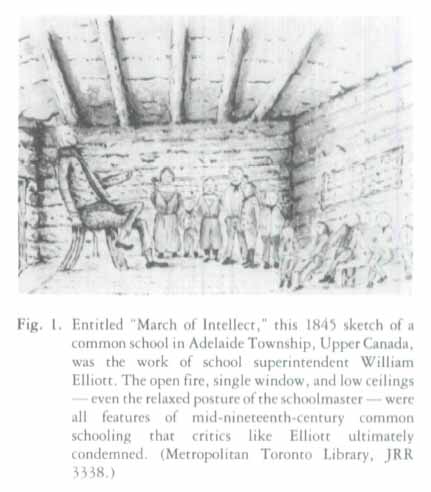 Display large image of Figure 1
Display large image of Figure 17 The casual approach that Thornton so deplored begins to suggest not only the relationship between the physical environment of the school and the character of the teacher's work, but the importance of the social environment as well. In the early household and family schools and even in the first one-room community schools, the attendance of the pupils was not only extremely unpunctual by modern standards, but also highly sporadic. No teacher knew which of his or her registered pupils would be in attendance on any given day or for what period of time they might stay once they did come to school. As late as 1882 schoolmaster D. Farquhar McLennan of Charlottenburgh, Ontario, noted in his diary the pupils who left at recess or noon and did not return. The delightful diary of Maggie Beattie, who taught near Morrisburg, Ontario, in 1898, records a constantly fluctuating number of scholars in attendance and, as well, the changeable weather conditions that could prevent school trustees from meeting in the same way that they often kept children at home.6
8 Of course weather was only one of the factors affecting school attendance.7 Both enrolment and daily attendance were also dictated by the length and character of the journey to school, by the numbers of children in a family, and by their parents' or guardians' ability to clothe them. Most importantly, they were dictated by the other work that children and young people had to do. Thus, on a particular September day in 1852, the teacher of a small country school in West Gwillimbury, Canada West, had no doubts whatsoever about why some of his pupils had stayed away. They were involved in the potato harvest.8
9 As Canadians were increasingly sold on the idea of regular schooling for their children and as more and more people left farm or bush to take up residence in towns, these material conditions of the teacher's work gradually changed. Although poor urban families continued to need the labour of their children and resisted regular and extended bouts of schooling for them, the general trend was toward increasing school attendance, both in terms of a lengthening school year and in terms of a growing number of days and years that any given child might continue in school. The promoters of increased and more regular schooling agonized over the "idleness" of the young and one suspects that it was chiefly urban youth that concerned them, as fears were expressed about the potential for juvenile delinquency that existed among the idle and unschooled in cities. Whatever their reasoning, by the end of the nineteenth century most provinces had enacted compulsory school laws to try to ensure that children under twelve years of age received several years in school. While these laws may not, in fact, have altered either rates of enrolment or attendance, they symbolized new attitudes to schooling and new conditions of work for teachers. Increasingly, the expectation was that most children would attend school for five days a week and for all of the school days of the year.9
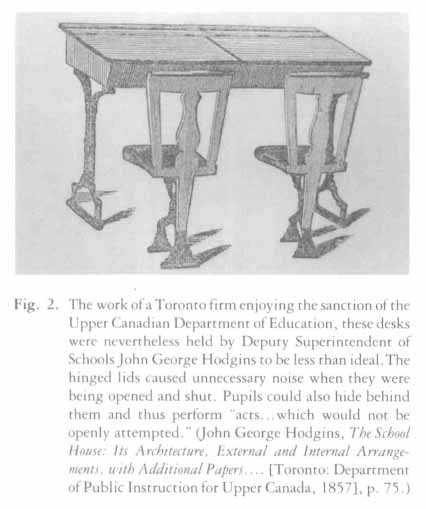 Display large image of Figure 2
Display large image of Figure 2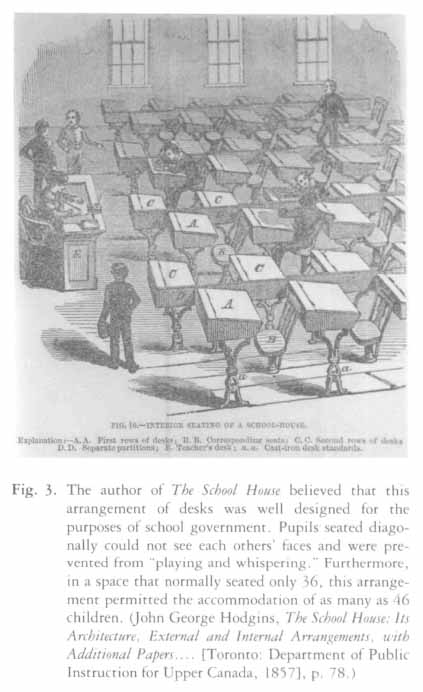 Display large image of Figure 3
Display large image of Figure 310 In the course of the nineteenth century, school "government" or the maintenance of order in school, was also both an increasing concern and a growing expectation. Clearly, in the early household or private schools, pupil numbers were so small that order was rarely a problem. Older scholars helped out with younger ones and parental discipline, even if this was frequently harsh, was the order of the day. But as teaching moved out of the household and into the public school, problems of control often developed. Numbers in any given school were larger. Indeed classes were frequently huge by modern standards. There were older children in attendance who had never experienced confinement in a school before; occasionally pupils were even older than the teacher. In these circumstances questions were increasingly raised about how best to keep order and systems developed for doing so. Students filed in and out of classrooms; individual seats, screwed to the floor, replaced benches and made it easier to keep pupils apart (figs. 2, 3); teachers introduced government-produced merit cards and other rewards to encourage orderly behaviour in their pupils.10
11 Other shifts occurred in the tools of the teacher's trade. Instead of allowing pupils to bring their own books, often texts which had been handed down from child to child in the family, provincial and local school authorities began to insist on uniform classroom sets of books. They also insisted that schools acquire blackboards, globes, and other Technologies unknown to the traditional domestic or even the early one-room school teacher (figs. 4, 5). From a pedagogy which focused on individual, if rote, recitations from the pupil's own book, teachers were urged to move to the "simultaneous" method of teaching. In this method, whole classes were instructed at the same time, a pedagogy that was suited to the larger, graded schools and also to more regular attendance, for it depended on entire classes of children being kept at the same place in the same book at the same time. The desire to create this kind of learning environment, indeed, was behind the building of larger schools and the intense campaigns to promote regular attendance among pupils. Simultaneous teaching, the method school reformers believed to be the most efficient, was impossible if students came irregularly or were unpunctual, or if children of all ages and stages of learning were mixed together and used a great variety of different books. Simultaneous teaching was also supposed to be-more stimulating to children and, according to the reformed pedagogy, teachers were not only to instruct and control their pupils but to interest them. No longer winding their individual ways through their own books and lessons, whole classes were now expected to rivet their attention on the teacher, or on the increasingly ubiquitous blackboard, and to work together. The ideal, according to one late-nineteenth-century American school superintendent, was that at any given time any given grade of children throughout the school in his city should be on the same page of the same book at the same time.11
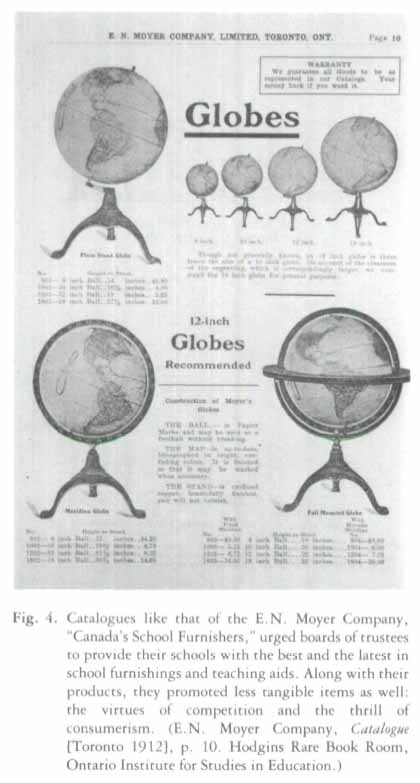 Display large image of Figure 4
Display large image of Figure 412 Thus the more structured learning environments that gradually developed in the course of the nineteenth century both dictated and made possible more formal and distanced approaches to the teacher's work. Early nineteenth-century teachers and many who followed them probably maintained whatever distance they could from their pupils with the use of the birch rod. In the 1860s, Toronto Normal School students were still learning when and when not to "flog," according to the notes of one of them, while in 1882 D. Farquhar McClennan reported the need to "whip" his pupils with amazing frequency.12 But formal pedagogies, larger schools and, perhaps, the presence of growing numbers of women teachers created a new kind of distance between teachers and the taught. And as teachers were increasingly urged to strive for a professional status superior to that of their scholars, social class factors were involved as well. The ideal teacher by 1900 was hardly an old gentleman lying on a bench as the pupils read to him or a gentlewoman quietly going about her business in her own household and instructing the young at the same time. The new teacher was a person who stood at the front of the room, actively pursuing the attention and allegiance of his or her pupils. The latter were, in theory and increasingly in practice, fixed in individual seats that were firmly screwed to the floor and were organized according to age and academic level in classrooms that were inside large buildings containing many other classrooms similarly organized (fig. 6).
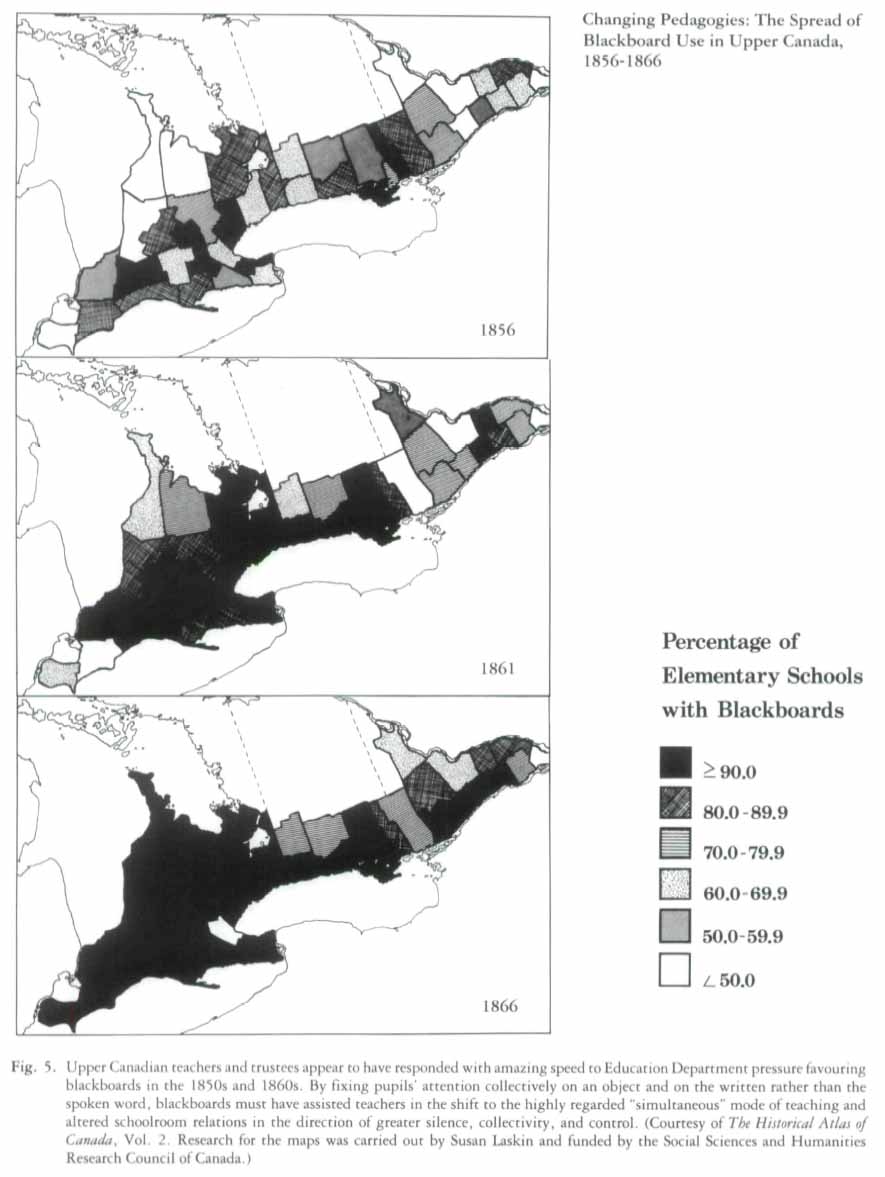 Display large image of Figure 5
Display large image of Figure 5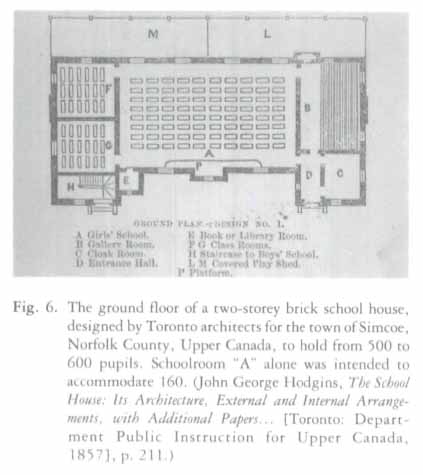 Display large image of Figure 6
Display large image of Figure 613 Over both teachers and the taught loomed the authority of a whole new set of educators whose presence gradually altered the conditions of work for the ordinary classroom teacher: principals, school board trustees, superintendents and inspectors and, ultimately, the provincial officials who ran the ever-growing bureaucracies known as provincial departments of education. Much that was new in nineteenth-century teachers' work was promoted by these authorities and the new often was hotly debated. Parents and trustees objected to the new subjects as they were introduced or to the new pedagogies. Some had no use for grammar; others had no intention of supplying the local teacher with a blackboard. In some rural Ontario communities at least, grammar and blackboards appear to have symbolized an alien culture, the unnecessary and offensive trappings of an all-too-distant metropolitan power.13
14 Another vigorously debated question involved what might best be described as the housework of the school, the laying of fires and the cleaning of the schoolroom. In 1848, the Chief Superintendent of Schools for Canada West, Egerton Ryerson, wrote that these matters were subject to negotiation between teachers and the trustees who employed them, the law not specifying who was responsible for the work of school maintenance. But arguments on the subject continued. One gathers that most local school trustees thought that the housework of the school was part of the teacher's job, while a good many teachers increasingly objected to doing it. Finally, in 1861, the Journal of Education for Upper Canada pronounced on the subject. The question was no longer one to be settled locally, at least in theory. According to the Department of Education, teachers were not required to make fires or to clean, much less repair, the school house. Teachers were employed only to teach school.14
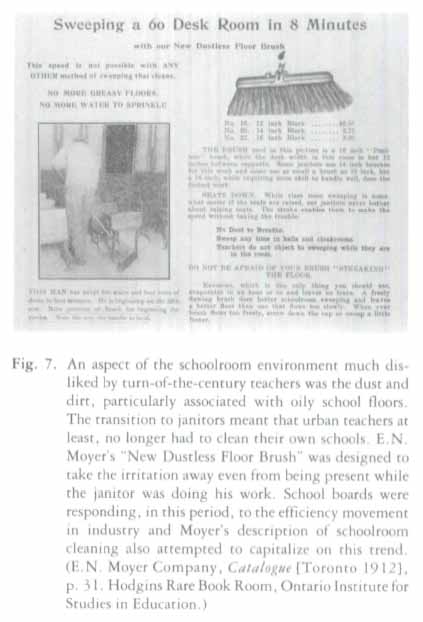 Display large image of Figure 7
Display large image of Figure 715 With the development of larger schools and more sophisticated methods of cleaning and heating, a separate category of caretakers evolved who specialized in the maintenance of schools and these debates eventually came to an end. Yet defining the boundaries of the teacher's work has continued to be a problem to this day. If teachers trying to establish themselves in nineteenth-century communities felt undermined or overworked if asked to perform the housekeeping tasks of the school, many contemporary teachers have felt the supervision of lunchrooms equally beneath their dignity as educators or, more mundanely, simply beyond their capacities in terms of time and energy.
16 Perhaps nowadays, however, it is the ever-increasing mountains of paperwork that most irritate the people who work in schools. This condition too can be traced to the nineteenth century. From the ubiquitous school register, which had to be filled in at least twice a day, to the growing numbers of tests and exams to mark, forms to fill out and reports to make, teachers even in one-room rural schools were more and more involved in written work, as were their pupils.15 Gradually spelling bees, mental arithmetic contests, and public examinations, and the oral culture which sustained these activities, gave way to the culture of the written word, once again substantially altering the conditions of the teacher's work. The hard work of keeping fires going and cleaning school houses may have disappeared, but only to be replaced by what many teachers would see as a different sort of drudgery.
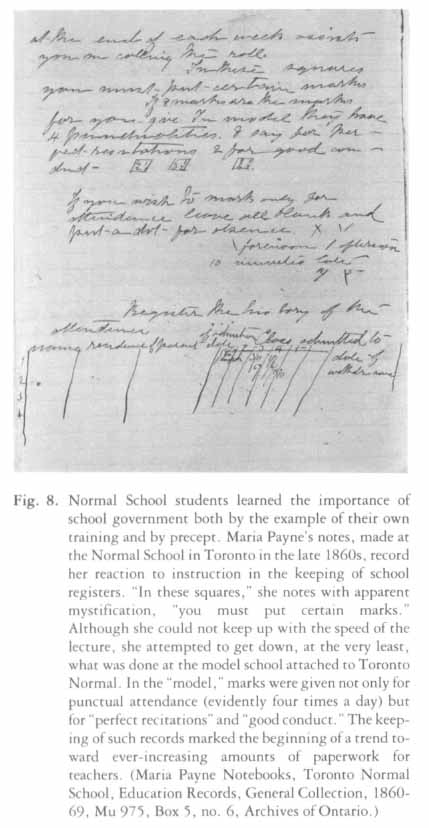 Display large image of Figure 8
Display large image of Figure 8II
One can imagine public examinations conducted by gentlemen teachers who, by virtue of their age, status, and gender, had the potential to exercise the kind of authority and showmanship appropriate to such occasions. Christmas recitals, on the other hand, may have seemed more suitable tasks for the young women who increasingly came to staff Canada's one-room rural, as well as larger urban, schools. This is only one of many possible illustrations of the relationships that may exist between the perceived characteristics of workers and the nature of the work they perform. When it came to the manual work associated with nineteenth-century rural schools, it may have seemed proper for male teachers to split the firewood for the school but not quite right for them to take on the cleaning. For young women, the opposite likely would have been the case, although one must beware of applying modern stereotypes to a pioneer society. Nevertheless it is clear that this reasoning applied to the use of the birch rod, which was gradually replaced, as teaching forces feminized, by the "strap" which, in its turn, was recommended for sparing use and, eventually, only by principals. In the large, graded schools where these same principals held sway, it was assumed that kindergarten and early grade school teachers would be women. The principals themselves and the teachers of the higher grades, on the other hand, seemed more appropriately male.16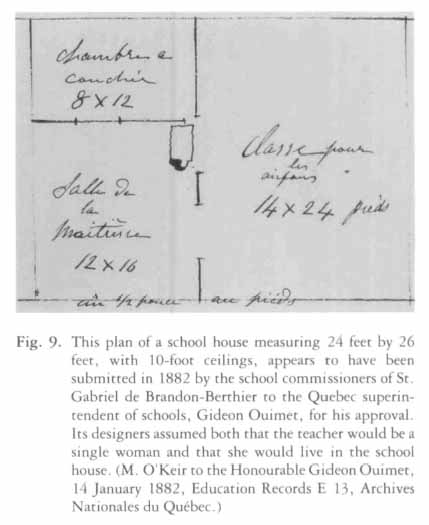 Display large image of Figure 9
Display large image of Figure 9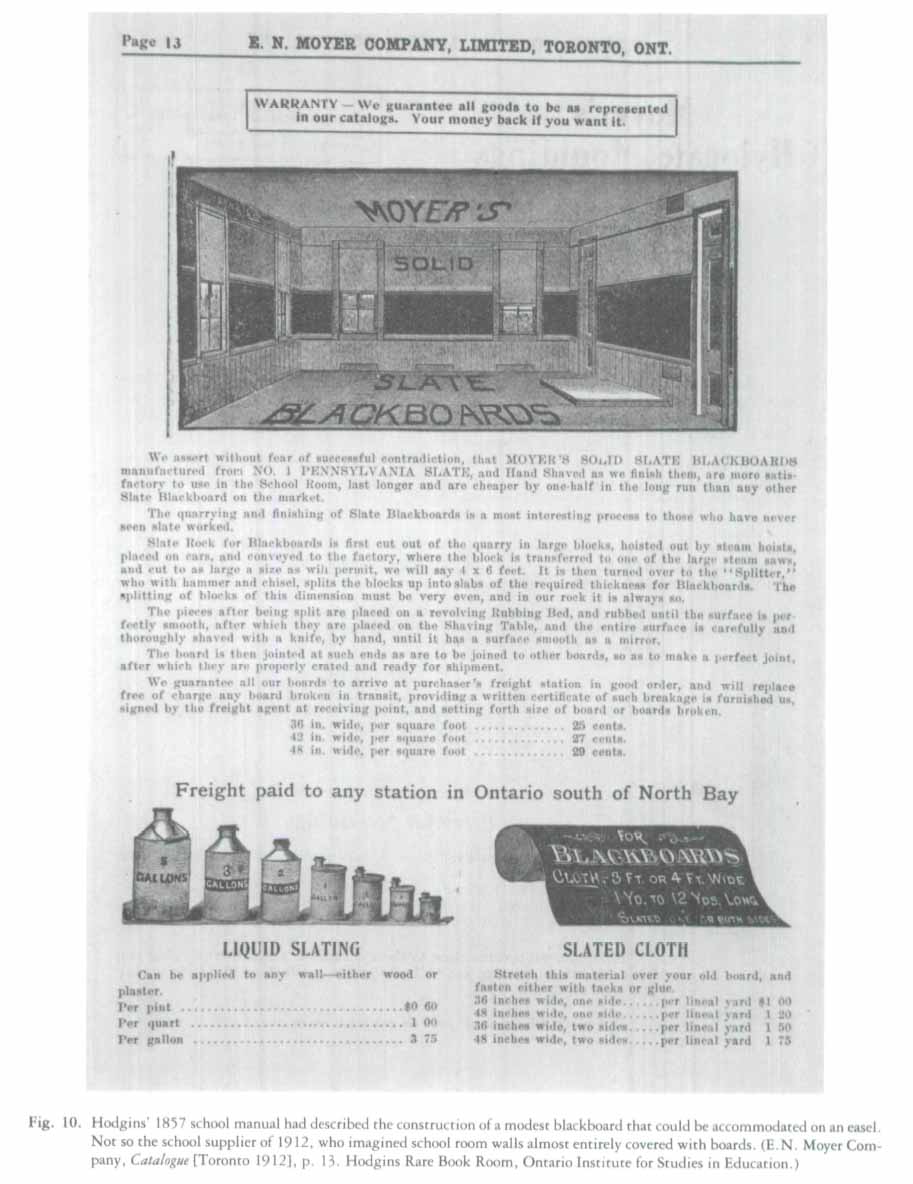 Display large image of Figure 10
Display large image of Figure 1017 Yet that the social structure of teaching has been a more complex and changeable phenomenon than such statements would imply is revealed when we examine questions such as gender more minutely. Statistical profiles of nineteenth-century teachers compiled from manuscript census returns currently available to researchers for the years 1851, 1861, 1871, and 1881, make such detailed examination possible for at least one brief but important period of Canadian history. Marta Danylewycz, Beth Light, and I have analyzed the changing characteristics of teachers during the third quarter of the nineteenth century for selected rural counties of Quebec and Ontario and for the cities of Montreal and Toronto, using these sources in conjunction with the records of local school boards and the provincial departments of education.17
18 If we begin with the two cities, we find that in Toronto feminization proceeded rapidly, especially in the schools controlled by the Public School Board until, by 1881, over 80 per cent of the teachers were women. In Montreal, the opposite occurred. Gradually, among the lay teachers employed by the Roman Catholic School Commission in the city, the men increased in proportion to the women until, by the end of our period, they were in the majority. In Montreal, in fact, large numbers of Roman Catholic women teachers continued in private or domestic teaching well beyond the period when most other Canadian teachers were abandoning this traditional form of educational work. An alternative, of course, was to join a teaching order and this was the path that many Quebec Catholic women chose. Convent schools multiplied rapidly in the second half of the nineteenth century and became preferred work-places for many middle-class and urban Francophone women teachers.18
19 Young lay women, however, continued to staff the poorer schools of rural districts in Quebec. Indeed, they did so in far greater proportions and from an earlier date than was the case for most parts of rural Ontario. In Quebec as a whole women were already the majority of teachers by the 1850s. Although certain eastern counties of Ontario followed the Quebec pattern of early female majorities among teachers, in rural Ontario as a whole male teachers continued to be numerically dominant for several decades longer.
20 We believe that the different rates and patterns of feminization in the two provinces can be explained by a combination of factors. Ontario, first of all, seems to have had a larger and more persistent pool of cash-hungry immigrant men who wanted teaching jobs than was the case in Quebec. The fact that young women were hired in disproportionate numbers in the poorer primary resource frontier regions of both provinces, where men were likely to be employed at least part of the time in industries such as lumbering and the fishery and where spare cash for teachers' salaries was in short supply, suggests that local economic conditions also played an important role. Finally, the persistence of the sexual segregation of pupils in the schools of Montreal — and its gradual disappearance in Toronto — may explain at least in part the different patterns which developed in these two cities. In Montreal, the Catholic School Commission was able to focus not only on boys' schooling to the almost virtual exclusion of girls', but also on the professional advancement of male teachers by choosing not to support many women's schools. The Public School Board in Toronto, on the other hand, paid more attention to the education of girls and also hired far more women; in Toronto, male career patterns and professional interests were nevertheless promoted, but through the creation of gender-based hierarchies within a rapidly growing and increasingly coeducational system.
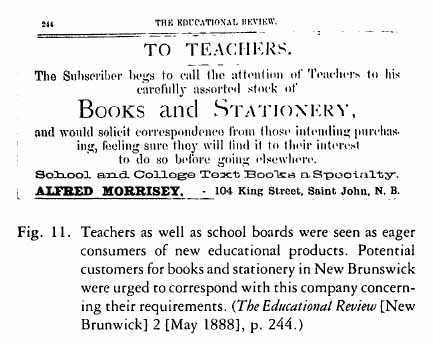 Display large image of Figure 11
Display large image of Figure 1121 If larger proportions of non-Canadian-born individuals among the male teachers of Ontario suggests a possible correlation between ethnicity and the sexual division of labour in teaching, the average ages and household positions of teachers also prove to have explanatory power. Men teachers were older than women on the average, in both Quebec and Ontario, and were far more likely to be either boarders or heads of their own households in all four census years. In Ontario the growing number of rural schoolmistresses meant not only an increase in the proportion of Canadian-born teachers but an increase in the proportion who were dependent young people living in the households of their parents. Evidently as rural trustees found that they were less and less able, to afford the salaries of male teachers or that fewer immigrant men were available for hire, they increasingly turned to the girls of their own communities in their search for teachers. In Quebec, where country districts adopted this pattern even earlier, an even greater need for economy evidently dictated that some 25 per cent of rural schoolmistresses not only had to teach but to live in the frequently inadequate school houses that were also the locations of their daily work.
22 From the social characteristics of the teachers we thus come full circle to be confronted once again with the character of the work-place and the work. Where boarding with different families in the community, being head of one's household or living in the school house were actually requirements of the job — and all of these at different times and places evidently were — such living arrangements must be treated as aspects of the teachers' work as well as of their private lives. In the nineteenth century, indeed, when public and private lives may have been more integrated than is the case today, household and employment status may well have seemed all of a piece. Women teachers, who tended to be young and dependent members of families, understandably had less status and earned lower salaries than male teachers, who tended to be older and heads of their households. Only those women who stayed in teaching for more than a few years and were making careers in the occupation began to feel the injustice of their admitted and, in some cases, growing inequality.19
III
23 Three overlapping periods can be discerned in the history of Canadian teachers, periods whose boundaries shift as one moves away from central places to thinly settled or remote regions where traditional forms have tended to persist. The first was the period of the domestic or private teacher, who predominated in most parts of Canada until at least the middle of the nineteenth century. During the second period, one-room public school teachers were probably the majority. Again, in most regions of the country this condition prevailed until at least World War I when one-room teachers, if no longer numerically dominant, were still often symbolically so. The vast majority of such teachers by the turn of the century were women and whether women or men, like their domestic predecessors, they often seem to have combined school teaching with other work. Male teachers were most often farmers, but they were also clergymen, surveyors, storekeepers, and clerks, while a late nineteenth-century Quebec woman teacher recorded in her diary long sessions of weaving in addition to her work in the school.20 For many teachers of this period, whether female or male, the one-room school was not only a part-time job, but a temporary one as well, to be abandoned to other school masters and mistresses at marriage or when other occupations beckoned.
24 Already evident in the latter part of the nineteenth century was the beginning of a new era and a third type of teacher, a person more likely than his or her predecessors to be engaged in teaching full-time and as a life-long career. No longer either inhabiting or working in one-room schools, these teachers were increasingly urban dwellers and the employees of large, bureaucratically organized school systems.
25 While this sketch of the transition from the keepers of private or domestic schools, through one-room school-mistresses and masters to the career teachers of the twentieth century can be suggestive only of the relationships between the characteristics of teachers and the character of theit work, it has tried at least to raise some of the key questions that such a study should probe. From the domestic and literary skills that Mary O'Brien and Anne Langton imparted to their pupils to the grade school work of today may not seem an enormous leap. What has clearly changed, however, are both the work-place and the larger social environment within which teaching takes place. More subtle to trace or assess in its effects, perhaps, is the shifting character of the teaching force, as old men lying on benches, housekeepers working at home, and teenage boys and girls have gradually been ruled out as appropriate instructors of the young, at least as far as public, tax-supported schooling is concerned. One need not idealize these teachers of the past to recognize that a great change has occurred between their time and our own.
* Originally presented in January 1983 at "Industrious in Their Habits: Rediscovering the World of Work," a Heritage Conference jointly sponsored by the Ontario Museum Association and the Ontario Institute for Studies in Education. The Ontario research reported in this paper has been sponsored by the Ontario Institute for Studies in Education, while the research on teachers in Quebec was supported by a Social Sciences and Humanities Research Council grant to my colleague in the study of teachers, Marta Danylewycz. I am grateful for this support and as well to Beth Light, who assisted with the study of teachers' characteristics using the manuscript census. My thanks also to John Abbott and Marta Danylewycz for careful and extremely helpful critical readings of earlier versions of the paper.